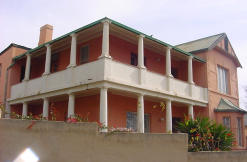
Gandhi’s memory lingers in SA
Sixty-five years ago today Mahatma Gandhi, one of the 20th century’s great spiritual leaders, was assassinated in India, at the age of 78. On 30 January 1948 Nathuram Godse pushed through a crowd around Gandhi, and fired three shots at point-blank range. He died on the spot. Gandhi’s 21-year South African sojourn nurtured the creation […]


Sixty-five years ago today Mahatma Gandhi, one of the 20th century’s great spiritual leaders, was assassinated in India, at the age of 78. On 30 January 1948 Nathuram Godse pushed through a crowd around Gandhi, and fired three shots at point-blank range. He died on the spot.
Gandhi’s 21-year South African sojourn nurtured the creation of his Satyagraha or passive resistance philosophy, spurred on by the racism that engulfed him from the moment he stepped off a ship in Durban. Satyagraha means “truth force” in Sanskrit.
His memory lives on in Johannesburg, the city he lived in for a good deal of his years in South Africa. A large, impressive bronze bust rests outside a permanent Gandhi exhibition at Constitution Hill, now the home of South Africa’s Constitutional Court, but then a place where Gandhi was briefly incarcerated several times.
There are other places in the city where his spirit can be felt – Satyagraha House, Gandhi Square, and Tolstoy Farm.
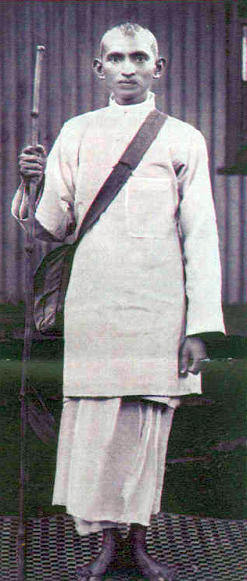
He is remembered in Durban too, where he lived for 10 years. In 1894, a year after he arrived in South Africa, he founded the Natal Indian Congress and in 1903, the British Indian Association in the Transvaal. He began the Indian Opinion soon afterwards, and a year later he established the Phoenix Settlement in Durban, an area of 100 acres, with the aim of promoting justice, peace and equality.
Gandhi, who is credited with being the driving force behind India’s independence from Britain in 1947, was, despite his small stature, a giant for many around the world. He inspired civil rights movements through mass civil disobedience. He is said to be the inspiration behind the African National Congress, whose policy of non-violent resistance remained in force until 1961, when a decision was taken to create an armed wing to overthrow apartheid.
He resisted discrimination and intolerance, particularly in India’s treatment of the untouchables, and its attitudes to Muslims. He was tolerant and knowledgeable of other religions. Although a Hindu, he believed that everyone’s relationship to God was a personal affair and in this sense he was a man of all religions.
Historian Jad Adams writes in the controversial Gandhi: Naked Ambition that he was ahead of his time in many ways. His ideas on healthy eating are fashionable today. He successfully fasted for peace in Calcutta, although fasting later became a manipulative political tool elsewhere. His simple style of living and dressing is still admired.
“As a man, he is most remarkable for making every day, perhaps every minute, a matter of reaching forward, for never settling in any one place in his long, intricate spiritual journey,” writes Adams.
This does not mean he was without contradictions and imperfections, but he will always be thought of as the “father of the nation”, says Adams, referring to India.
Arrival in South Africa
Gandhi arrived in South Africa in 1893 to handle a legal case in Pretoria, and settled in Durban before moving to Johannesburg in 1903.
Several events in South Africa were decisive in his growth – he was thrown off a train at Pietermaritzburg on his way to Pretoria, and after struggling to find a hotel in the city, he was told that he could not eat in the dining room of the hotel. Later, he was removed from the pavement outside President Paul Kruger’s house and told to get a pass to walk Pretoria’s streets.
Gandhi said of his experience in South Africa: “Truly speaking, it was after I went to South Africa that I became what I am now. My love for South Africa and my concern for her problems are no less than for India.”
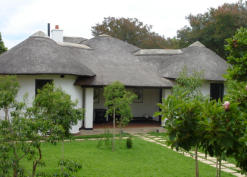
Nelson Mandela is quoted as saying: “The spirit of Gandhiji may well be a key to human survival in the 21st century.”
His time in Johannesburg
The early period of Gandhi’s stay in Johannesburg was taken up with establishing his legal firm, but from 1906 he became actively involved in politics.
When Gandhi first came to the city he lived in rooms behind his law offices in Rissik Street. Henry Polak was a partner in his law firm and Gandhi later moved into Polak’s house in the suburb of Bellevue East.
He also stayed in a house at 11 Albermarle Street in Troyeville, this time with his family whom he had brought up from Durban. The house is now a provincial heritage site.
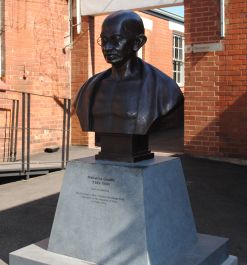
Gandhi used to practise as an attorney at the Johannesburg Law Courts, the city’s first law courts, in what was known as Government Square, and in use until 1911. The law courts were demolished in 1948 and made way for the city’s main bus terminus. Although still a transport hub, the square has been renamed Gandhi Square in recognition of the man who worked there.
In 2003 the City of Johannesburg unveiled an elegant bronze statue of Gandhi in the square, depicting him as a young lawyer, with a book under his arm, looking determinedly forward, with the breeze blowing his cloak to one side. He looks into the centre of the square, and standing on top of a five metre-tall plinth, is an imposing figure.
Gandhi was a concerned citizen and when the Anglo-Boer War broke out in 1899, he became involved. A contingent of 7 000 non-combatant Indians came out to South Africa to help with the British war effort. Gandhi was a loyal British subject and encouraged local Indians to help – he got together 1 000 stretcher-bearers.
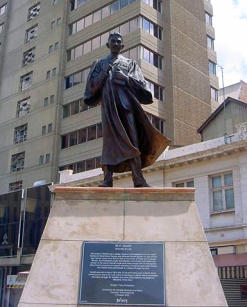
Bubonic plague struck Johannesburg in 1904, at the Indian settlement behind what is now the Market Theatre in Newtown. Gandhi was not deterred by the disease’s contagiousness and together with an Indian doctor, set up an emergency hospital, recruited several volunteers, rolled up his sleeves and nursed the sick.
Asiatic Law Amendment Ordinance
It was a racist law in Johannesburg that helped Gandhi formalise Satyagraha. The Asiatic Law Amendment Ordinance of 1906 proposed that Indians and Chinese were to register their presence in the Transvaal by giving their fingerprints and carrying passes. The protest to the act united the two communities and they decided to oppose the ordinance by peaceful methods.
Protestors got together at the Empire Theatre in Ferreira Street, since demolished and now a rather nondescript Ferreira House, and Gandhi spoke to the protestors under the theme of violence begets violence.
“Up to the year 1906 I simply relied on appeal to reason. I was a very industrious reformer … But I found that reason failed to produce an impression when the critical moment arrived in South Africa,” he is quoted as saying in Eric Itzkin’s Gandhi’s Johannesburg, birthplace of Satyagraha.
“My people were excited – even a worm can and does turn – and there was talk of wreaking vengeance. I had then to choose between allying myself to violence or finding out some other method of meeting the crisis and stopping the rot, and it came to me that we should refuse to obey legislation that was degrading and let them put us in jail if they liked. Thus came into being the moral equivalent of war.”
He and hundreds of others were arrested, and taken to the Fort on Constitution Hill.
Transvaal colonial secretary Jan Smuts called Gandhi to his office and offered to repeal the law if Indians and Chinese registered voluntarily. Gandhi was censured by the community for agreeing to this – he was called a traitor and severely beaten.
Meanwhile, the community registered under the law but Smuts went back on his word – the new law was passed as the Transvaal Asiatic Registration Act of 1907. In response Gandhi encouraged his colleagues to burn their passes, which happened outside the Hamidia Mosque in Newtown. The mosque still stands.
Gandhi and his passive resisters did not win the battle. As a British subject he made an appeal to the British and they put pressure on the Transvaal government, which eventually repealed the act. But when the Transvaal became self-governing in 1907 it promptly reintroduced the Pass Law Act in 1907 and even after further burning of registration certificates, the movement started losing momentum and by the middle of 1909, most Indians had registered for fingerprinting.
Satyagraha House
The Kraal, the house where Gandhi lived with his architect friend Hermann Kallenbach for several years in the residential suburb of Orchards, has recently been lovingly restored by a French tour company, and renamed Satyagraha House.
It was opened in late 2011 and operates as a museum, guesthouse, and restaurant, being marketed as a heritage destination for “liberation tourism”.
The house, at 15 Pine Road, was completed in 1908 and Gandhi and Kallenbach lived in it until the end of 1909. It was built on a kraal principle, with two-bedroom rondavels abutting a lounge which led on to a stoep, from which a kitchen flows. The previous owners enclosed the stoep with tall wooden concertina doors, which have been retained, as has the addition of two bedrooms at the back of the house.
An interesting feature of the house is that the rondavels do not open into the dining room, but have outside doors. Kallenbach wished to keep them as independent structures, to emulate a conventional kraal. In addition, the original house had no passages.
The house is a metaphor of simplicity, just as Gandhi lived his life, with period pieces imported from India. It is finished with pure white walls and wood and white concrete floors, with black framed windows and doors, and black ceiling beams juxtaposed against the thatch roof. Tables, chairs and cupboards are in natural wood, while curtains and linen are Indian cotton. Decor in the rooms consists of woven baskets, smooth black ceramic pots and grass mats. Artefacts include kitchen implements from the early 1900s, a weaving machine and chests.
Large black and white photographs fill the walls, together with panels with quotes capturing his philosophy, and an extensive book collection in both French and English.
The guesthouse has nine rooms in the house and cottage, a later addition which has remained, as well as a new section. Guests can also stay in the loft room, where Gandhi slept on a mattress on the floor.
In those days the house was surrounded by virgin veld.
Tolstoy Farm
Hermann Kallenbach later bought 1 100 acres of land 35 kilometres south-west of Johannesburg, and gave it to Gandhi and his passive resisters. It became known as Tolstoy Farm and was run on the principles of a kibbutz. Men and women were housed separately; they grew their own vegetables and fruit trees.
Itzkin describes the farm: “At its height Tolstoy Farm supported a community of about fifty adults and thirty children but by April 1912 most of the Satygrahis’ families had left, since passive resistance had been suspended after an interim agreement with Smuts. Gandhi left the farm on 2 January 1913, leaving behind only Kallenbach and the Africans who lived there.”
All that remains of the farm these days is the open space and the pleasing vistas.
Exhibition at Constitution Hill
A permanent exhibition at Constitution Hill, titled Prisoner of Conscience, traces Gandhi’s history in the country, and with photographs, quotes, artefacts and audio material, details the experiences that shaped his development. It is housed in the former visitors’ centre of Number Four, one of the country’s most brutal apartheid prisons.
The exhibition symbolises Gandhi’s transformation through his attire – from a besuited lawyer to wearing rough prison garb to a man in a simple cotton tunic, on his departure for India in 1914, aged 46. Gandhi was transformed from a shy lawyer into a world-renowned leader.
Of his short spells in jail on what’s now Constitution Hill, he said: “I am not in the least thankful for having been released. I preferred the solitude and peace of prison. It gave me the opportunity and time for meditation.”
Hindu crematorium
Gandhi played a role in the building of the first Hindu crematorium in Johannesburg, and the first in Africa. In 1908 he was approached to help find a suitable plot for a crematorium. He negotiated with the town council and land in the Brixton Cemetery was allocated for the crematorium.
Finally, after Gandhi had left the country, the wood-burning crematorium was built in 1918, and it stands today as a national heritage site. A gas-fired crematorium, which is still used, was built next to it in 1956.
Gandhi felt his job in South Africa was complete, and he made plans to leave the country, which he did in 1914, to develop further his ideology in India.
Gandhi wrote in one of his autobiographies that he would “always be a South African Indian”.
• Satyagraha House: Tours of the house are available, with or without lunch. The house is open from 8am to 5pm, Mondays to Sundays. Book a 45-minute tour on  +27 11 485 5928.
+27 11 485 5928.
Source: www.mediaclubsouthafrica.com
